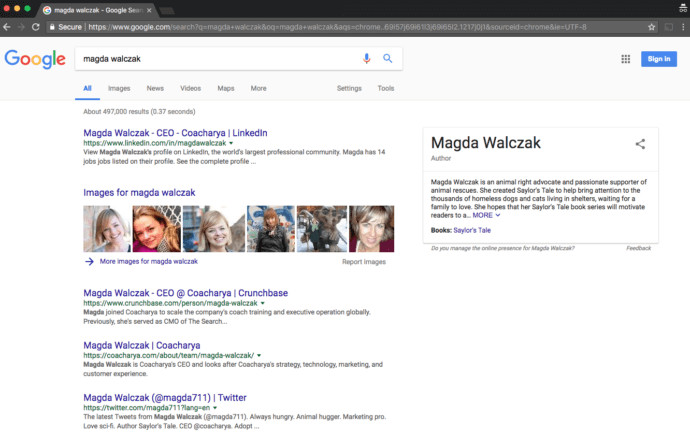Whether you like it or not, your prospective clients are checking you out. They’re heading to LinkedIn to verify that you have professional coaching credentials, and they’re definitely googling you. What they see can make the difference between you getting the job or missing out. As professional coaches, one’s reputation – offline and online – is of incredible importance.
Since most coaches aren’t marketing pros and may not even use social media (you should at least have a complete profile on LinkedIn!), you may not know if there’s even an issue. And you may not know how to fix it if there is. Hopefully, this blog post will help.
So – how do you take control of your Google search results?
Step 1 – Find out what others see when they search for your name
In order to get the best idea of what others see when they google you, it’s not enough to just go to google.com and put in your name. If you have a Google account and you’re logged into your account somewhere, Google is collecting information about your browsing behavior. It then uses this information to customize what search results you see. So if someone searches for you, their results may be different from what you see when you make that same search.
While you will never be able to see all the versions of search results about you that are possible, using “Incognito” or “Secret” mode in your web browser is a good way to get an overview. For example, here’s what I see when I incognito search myself:

Looks like a few of the images aren’t me, but that’s OK. I’m not the only Magda Walczak in the world :). All the other searches are either ones I can edit, or they’re benign (for example, a link to a list of all the Magda Walczaks that have Facebook profiles).
Step 2 – Review the top search results
At the very least, you should take a look at all the listings that appear on the first page of search results. If you want to be a bit more meticulous, take a look at the first 3 pages of results.
The first thing you’re looking for is what’s on the surface – are the descriptions of all the results on this page accurate? Are they positive or at least neutral?
Second, you’ll want to click through on each result (tip – open each result in a new browser tab/window). Read the full text of what’s on the page and make a note if anything is inaccurate or negative. This second step is a bit tedious, but you want to know what your potential customers would read, wouldn’t you?
When I did this exercise last time, I actually found a bunch of profiles on business websites, which I didn’t know existed. I also found a profile I originally submitted on Crunchbase where my previous role was listed, not my current Coacharya one. None of these were damaging or negative, but they were still things I wouldn’t know about otherwise.
Step 3 – Edit what you can
Now that you have an audit of what’s out there about you, take charge and make changes. Some of the search results you found aren’t things you can do anything about, so focus on the ones you can. For example, you can edit your short bio on your social media profiles as well as listings on professional membership websites.
Each item that appears in search results will only show maximum of 300 characters of text, usually less. Unfortunately, you can’t control exactly which part of the page Google will show as that short 300 character max snippet. The likeliest portion that will show will be whatever is directly after your name. Take a look again at the screenshot I included above. You can see that every result includes my name and content that’s directly after it on the page.
Step 4 – Try to “push down” things you don’t like
Sometimes you’ll find results you don’t like, but you can’t edit these. For example, someone got angry at you and vented their feelings publicly on a forum or in a review.
The good news is that most websites will have a “contact” page somewhere and many have a “flag for review” feature, or similar. In cases where there’s an option to dispute the post, you should definitely follow that website’s steps to do so.
Unfortunately, it’s possible that you’ll never get a reply, or the site can even refuse to do anything at all. When that happens, the best you can do is try to “push down” a negative search result.
One way to do this is to edit the other items that come up in your search results, to make them most current and relevant. In general, fresh data is more relevant and may therefore rank higher.
The second way is to create other profiles, pages, etc. on reputable websites in hopes* that their “freshness” would be more relevant and therefore rank higher when people search for your name. For example, if you don’t already have profiles on these popular ranking sites, create them; try LinkedIn, Instagram, Facebook, Twitter, Crunchbase, etc.
*I say “in hopes” because nothing is guaranteed here. All you can do is use these best practices and see how the search results change over time.
Step 5 – Check other relevant terms
At the very least, you should check the status of search results for your name. I recommend checking other relevant terms such as your name combined with the word coach, coaching or your company name. The search results will be very different with more detailed phrases.
For me, I looked at “Magda Walczak CEO” and “Magda Walczak book,” for example.
Step 6 – Watch for changes
Like with any SEO activities, optimizing your own name search results takes time and there are no guarantees. For coaches (and for most people, I’d argue), your reputation is important both personally and professionally. You might as well take the steps you’re able to protect it.



